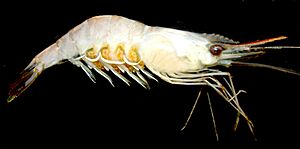Amazon river prawn facts for kids
Quick facts for kids Amazon river prawn |
|
|---|---|
 |
|
| Conservation status | |
| Scientific classification | |
| Genus: |
Macrobrachium
|
| Species: |
amazonicum
|
The Amazon river prawn (scientific name: Macrobrachium amazonicum) is a type of freshwater prawn. It's important for people because it's often caught for food. You can find these prawns in warm, wet parts of South America.
Contents
What is the Amazon River Prawn?
Amazon river prawns can grow quite big! They can reach about 16 centimeters (about 6 inches) long. They can also weigh up to 30 grams (about 1 ounce). Male prawns are usually larger than females.
Male Prawn Types
Male Amazon river prawns have four different looks, called morphotypes. These types are based on how their claws look.
- Translucent Claw (TC): These are the smallest males. Their claws are mostly clear, with a slight green color.
- Cinnamon Claw (CC): These males are a bit bigger. Their claws have more green and some brownish spots. This makes them look beige.
- Green Claw 1 (GC1): These are larger males. Their second pair of claws is very big and moss green.
- Green Claw 2 (GC2): These are the largest males. Their green claws are even longer than their whole body!
Other types of giant river prawns, like the Macrobrachium rosenbergii, also have similar claw types.
Where Do Amazon River Prawns Live?
You can find the Amazon river prawn in many countries in South America. These include Guayana, Surinam, French Guiana, Brazil, Colombia, Venezuela, Peru, Ecuador, Bolivia, Paraguay, and Argentina.
They live in all the major river systems in eastern South America. This includes big rivers like the Orinoco River, the Amazon River, and the São Francisco River. They also live in the Araguaia-Tocantins and La Plata river basins.
In the São Francisco River, these prawns were probably brought there by people around 1939. They were introduced to be a food source for fish. Now, they are very common in that river. Scientists are still studying how this might affect other native species in the area.
Why Are These Prawns Important?
Even though not many Amazon river prawns are caught by big fishing companies, they are very important. They make up most of the wild freshwater prawns caught in Brazil.
These prawns are a key food source for many traditional communities. Especially in the Brazilian states of Pará and Amazonas, people have eaten them for a long time. They are also enjoyed by many other people in Brazil.


